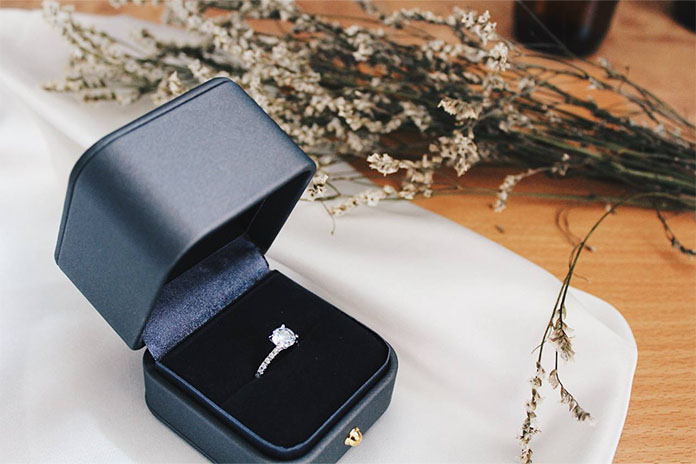
THREE graduates of the Singapore Management University put their heads together and came up with a sparkling idea — create engagement rings from eco-friendly, conflict-free materials.
Ng Ying Zhong, Tan Guan Wei and Vivian Poo (L-R above) collaborated in a few months to form luna a brand offering affordable engagement rings using moissanite, which costs a fraction of the price of a diamond ring.
Hear more about luna at the WED WEB CHAT — The Maker Mindset on 4 August 2021 from 12:45-1:30pm. You can register for the session by clicking on this link.
It Used To Be About Diamonds
Diamonds are synonymous with elegance and symbolic of eternal love.
While the precious stone is often associated with luxury, recent trends are showing that diamonds are losing their shine.
ALSO READ: PLAYING THE JOKER CARD
In a 2021 Bain report, it found that diamond sales have been dropping since 2018. In 2020, production for diamonds fell 20% compared to levels in 2019. The problem was exacerbated by Covid-19; decreasing diamond sales a further 33%.
One leading cause for this trend are millennials shunning traditional mined diamonds and actively looking for alternatives like lab-grown diamonds and moissanite. This generation of consumers is value conscious and have concerns about the environmental and ethical issues with diamond production. These concerns, in turn, have made nearly 70% of millennials consider purchasing a lab grown alternative instead.

Dirty Deeds
Mined diamonds are inherently dirty.
A BBC report states that 250 tonnes of earth are moved per carat of diamond — a reason why some diamond mines take up so much land that they can be seen from space. The report also suggests that 160kg of CO2 are produced per polished carat, which is equivalent to driving a petrol car for more than 600km.
With roughly 111 million carats of diamonds mined every year, the environmental impact of these diamond mines is immense. A report commissioned by the Diamond Producers Association recommended that the industry should reduce the environmental impact of diamond production in terms of pollution, greenhouse gas emissions and recycling of mining site waste.
ALSO READ: THESE EARPHONES SOUND SHARP
Another key concern for mined diamonds is the issue with blood diamonds. Popularised by Leonardo DiCaprio in the 2006 film Blood Diamond, it shed light on the ethical and humanitarian issues associated with mining diamonds. 15 years after the release of Blood Diamond, the industry still doesn’t seem to have shaken off the negative image.
Human Rights Watch looked at the sourcing practices from 15 of the largest diamond retailers, which included household names like Tiffany & Co, Cartier and Chow Tai Fook. They found that a majority of these companies are not able to trace where their diamonds come from, nor do they do enough to prevent human rights violation. The violations discussed include mistreatment of the local population, child labour and the funding of war crimes.
The Human Rights Watch also labelled diamond mining as “The Worst Forms of Child Labour”, exposing children to extreme levels of danger.
With lab-grown gems taking up only a tenth of the energy required per carat with significantly less ethical and environmental implications, companies are beginning to consider these alternatives. The largest jewellery company in the world, Pandora, switched to only selling lab-grown diamonds in 2021, citing the changing taste preferences and the push towards sustainability as an impetus for the shift.
Sparkling Replacements
Cubic zirconia and moissanite are relatively new players in the diamond alternative space.
Cubic zirconia is a man-made material and costs about 5% of the price of a diamond of equivalent size. Used since the 1980s, it is a cheaper alternative, though it does scratch from daily use and tends to discolour.
ALSO WATCH: PANDEMIC YOUTH ISSUES
Moisannite was discovered in a meteorite in 1893 by a French chemist, and is only found in small quantities in nature. The process of creating lab-grown moissanite was patented in 1995, but the popularity of the gem only took off recently, mainly due to the fact that it costs just 10% of an equivalent diamond.
It is virtually impossible to tell the difference between a diamond and a moissanite with the naked eye. Since moissanites are created in the lab, the clarity and colour of the gem is on par with the highest graded diamonds. Most moissanites are colourless (DEF) and are graded as flawless (VVS1) on the diamond rating. With a refractive index of 2.65-2.69, it is more refractive than diamonds. Moreover, moissanite gives off fiery rainbow flashes making it appear more “sparkly” compared to diamonds.

The founders of luna opted for moissanite for their engagement rings, which are made by local craftsmen. While keeping a local trade viable, it also brings that eco-friendly element to appease the environmentally aware millennials who are about to take their next steps into the future.
Hear more about luna at the WED WEB CHAT — The Maker Mindset on 4 August 2021 from 12:45-1:30pm. You can register for the session by clicking on this link.




















